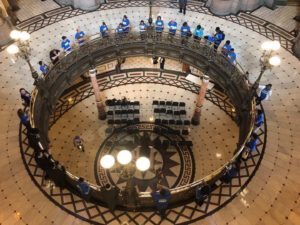Maryland nonpublic schools given funds to reopen
(The Center Square) – Maryland doled out $1.6 million in unspent funds to help the state’s nonpublic schools ramp up to come back online and reopen this fall.
Leftover funding from last year’s…

(The Center Square) – Maryland doled out $1.6 million in unspent funds to help the state’s nonpublic schools ramp up to come back online and reopen this fall.
Leftover funding from last year’s Emergency Assistance to Non-Public Schools funding was used to cover expenses related to COVID-19 recovery, according to Gov. Larry Hogan’s office. Expenditures include supplies to sanitize and disinfect school facilities, improve ventilation systems and educational technology, expand capacity for coronavirus testing and contact tracing and reasonable transportation costs.
The funds were used to entice schools to improve ventilation systems, said the head of the Maryland Association of Nonpublic Special Education Facilities. Students were to benefit from building cleanings, with the school itself indirectly benefiting.
“It’s a very small amount of money if it’s been leftover. I think it’s only $1.6 million,” Dorie Flynn, executive director of MANSEF, told The Center Square.
Qualifying nonpublic schools are based on the number of low-income students enrolled.
“This is not going to a prestigious, private pay, where moms are writing a $35,000 tuition check. It’s not that group of nonpublic schools,” she said. “Georgetown Prep did not get any money. They do not qualify with having low-income students. They don’t have enough low-income students.”
Most of the schools represented by MANSEF are ineligible.
“But it’s simply the result of COVID and the expenses and the enormity of what every school in the country had to go through to get back online here and get back open,” Flynn said.
Maryland has three different types of nonpublic schools, she said, the independent private-pay schools, the church-exempt schools, and the special education schools. Parents write a tuition check for the private-pay schools, and church-exempt schools are another group of private-pay schools.
If a public school cannot serve a student based on individual special needs, the school system makes a referral to a nonpublic special education school and pays the tuition.
“To qualify for this money, this leftover money, you need to be approved by the State Department of Education,” Flynn said. “And you have to go through a door of another grant program that the state also runs. It is very complicated.”
Maryland has more than 1,200 nonpublic schools, the head of the Association of Independent Maryland & DC Schools said. They are various sizes and types, with many having a religious orientation.
“What they have in common is that they are not part of the state public school system,” AIMS Executive Director Peter Baily told The Center Square. “Independent, nonpublic schools have existed in North America since before the United States existed. Several independent schools founded in the latter 1600s are still in operation today. Independent schools have always been an important part of the educational landscape, even before public education existed in the United States.”
Baily said they provide significant need-based financial aid to families so that socio-economic diversity can be supported within the school community. Last year they awarded $230 million in need-based financial aid.



